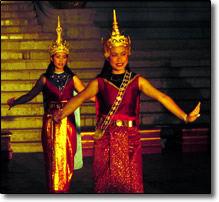
Buddhist New Year
Buddhist New Year is notorious for water splashing. Since we were resigned to spending this holiday in a Buddhist country, we decided that we had the best chance of avoiding an aggressive soaking with the meek Lao. In Luang Prabang, the festival starts with a day of making sand stupas on an island in the Mekong . Here we looked up a friend of a friend who was Lao, “Outh”, and she took us along to show us what to do. After buying a paper flag with colored animals on it, we rode across the river to a sandbank. Thousands of people were there, eating, drinking and piling up sand to build their stupas. It was hard to find an empty space along the bank to build on! Some friends of Outh threw Anne in the river and smeared our faces with black grime, then another group of revelers came along beating a gong and smeared my face with blue ink. To compensate I was given a drink of Lao whisky. It was all part of the fun. Our stupa finished, we sprinkled it with white powder and planted the flag, then made a quick prayer before anyone could stagger over it.
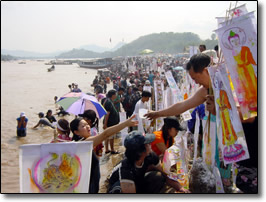 |
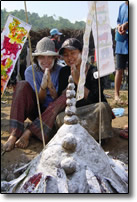 |
As we made our way back to the streets of Luang Prabang, we were now constantly soaked by people with buckets and squirt guns. “Thank you” and “happy Buddhist New Year” was Outh's constant, cheerful response. Not only do you get soaked, but you have to be thankful for it! With the oppressive heat, it did feel wonderful, and my camera was safe inside a plastic bag. Outh explained that the water was supposed to wash away the sins of the previous year, so we should be grateful to those who splashed us. If we didn't want to get wet, though, we could, being Westerners, sometimes browbeat the water-throwers into holding their fire. Outside of town was a giant fair with food, rides, games and performances. There was a fashion show and a beauty contest to choose a “Miss Luang Prabang” to play a key role in the ceremonies. Seven ladies were in fact chosen to take part in the New Year's parade, the main event of the New Year celebration.
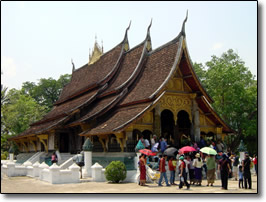 |
 |
Here was a chance to see Luang Prabang at its finest. Actually there are two parades on consecutive days. A four-headed statue, Phagna Kabilaphom, is taken from Wat That Noy and brought to Wat Xieng Thong. On the next day it is returned. With marble steps and long, overlapping, sloping roofs covering decorated golden walls, Wat Xieng Thong is a masterpiece of Lao architecture. Inside, before the golden Buddha, knelt the seven chosen ladies, dressed in their finest traditional clothes. Miss Luang Prabang accepts the four-headed statue; it is carried out of the temple and through the courtyard, followed by orange-robed monks and well-dressed onlookers, to the waiting parade on the main street.
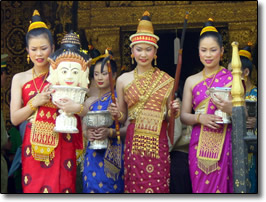 |
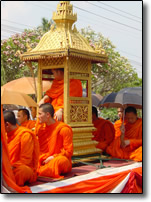 |
Formerly the “miss” would ride an elephant, but that has been replaced by a painted model mounted on a moving platform. The march begins. The UNESCO heritage charter is carried by four bearers in red and orange suits. Six of the beauty queens stroll by with crowns on their head and beautiful silk robes. The “miss” rides by in her motorized elephant. There are ladies in traditional costumes and groups of black-suited musicians playing gongs, drums and long bamboo pipes. “Pou Gneu” and “Gna Gneu”, two mythical protectors of the city, wear red masks with long, stringy manes. They dance with their mascot: a red-masked, maned lion.
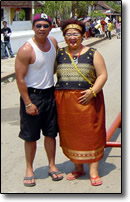 |
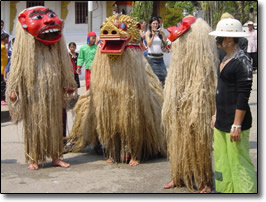 |
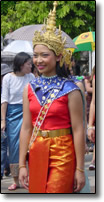 |
A flatbed truck drives by with a giant wooden drum. A monk is carried in a golden pagoda. He is followed by a line of orange-robed novices carrying umbrellas. The spectators jump into action - taking cups and bowls, they splash the monks with water! The poor monks do their best to refrain from cringing and keep smiling as water rains down on them from all sides. In fact, everybody in the parade gets a good splashing from the sidelines. At the back of the parade come the ladyboys - svelte transvestites wearing skimpy outfits. One is dressed in a traditional costume, mocking the beauty queens. They gyrate, dance and splash water on each other and their excited followers as they continue after the parade.
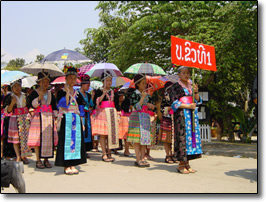 |
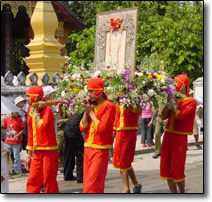 |
Later in the afternoon the party really starts. Kids in pickups armed with buckets of water drive up and down the street, blasting music and throwing water. Motorcyclists are doused as they pass. Now the tourists have joined in, bringing heavy-duty compressed-air water guns. Nobody is spared from a good dousing.
As with all festivals in Asia, there was plenty of street food to sample. One specialty was sticky eggplant goo wrapped in lettuce leaves and dripped into a sweet spicy sauce. There were also “summer rolls” - spring rolls with fresh herbs not fried but eaten fresh.
That night was a special dance performance in the former royal palace. To kick off the show, a dragon trailing a train of colored lights came down from Wat Phousi, Luang Prabang's most renowned hill temple, into the courtyard. Masked dancers performed scenes from the Ramayana. Sita, the leading woman, was exceptionally elegant and supple. Halfway through the performance a flying squirrel whooshed over the heads of the audience.

